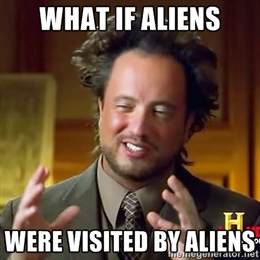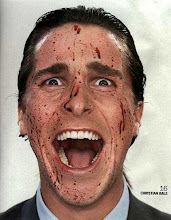 |
| "Thats a man baby!" |
Dan Brown: Absolutely all of it. Obviously, there are—Robert Langdon is fictional, but all of the art, architecture, secret rituals, secret societies, all of that is historical fact.
Perhaps Dan is being a bit ambitious when he says historical fact. The da Vinci code and the subsequent film of the same name have come under tremendous scrutiny because of Dan Browns approach to historical fact. Though "based on a true story" has become a popular trope in late twentieth century fiction his claims have been particularly controversial or even offensive to some because of how they conflict with established teachings about the life of Jesus. More importantly, Dan Browns claims conflict with the accepted historical narrative and contemporary scholarship. Though books labeled "fiction" (or hollywood movies) are not typically considered a venue for serious historiographic debate Dan Browns radical revisions on the history of Christianity are seen as entirely factual by many. That fact not withstanding, Browns "historical accuracy" is a speculative counter factual history as we shall see.
The film revolves around two characters, Robert Langdon and Sophie Neveu, who through a serious of mysteries and adventures discover a centuries old secret being concealed by the catholic church. A cabal by the name of the priory of scion protects this secret. A secret that if revealed could change the face of western civilization as we know it. The secret is that the legendary holy grail was not as so many have assumed, an actual vessel from which Christ drank during the last supper, but was instead was the womb of Mary Magdalene. After the death of Christ marry gives birth and this begins a bloodline that exists to this day. Over the centuries the albino assassins of opus dei (portrayed in the film as scheming and murderous protectors of the church) have pursued these decedents of Christ seeking to exterminate them and all trace of their existence. They do this ostensibly out of fear that the revelation of Christs existing bloodline might usurp the catholic churches place of privilege and power in Christianity. Over the centuries many have been initiated to the secret. This is the cue for Leonardo da Vinci to enter the show. Da Vinci hid within his art and writing the clues necessary to discover the shocking truth of the film. It is through these clues that our protagonists begin their story so lets start there. . .
 |
| Hi Dan! |
 |
| So, hows it going Dan? |
What about the priory a scion? The secretive cabal that seeks to protect the airs of Jesus and Mary Magdalenes sacred bloodline from the opus dei assassins? Well, turns out its pretty much just made up. The priory myth was invented by Pierre Plantard in 1956 and he admitted as much himself during an investigation into charges of insider trading by Patrice Pelat, who, Plantard had claimed, was a grand master of the priory. To wit:
When Judge Thierry Jean-Pierre became the presiding French Judge heading the enquiry into the Patrice Pelat financial corruption scandal of the 1980s, Plantard voluntarily came forward during the 1990s offering evidence to the inquiry, claiming that Pelat had been a "Grand Master of the Priory of Sion". The Judge ordered a search of Plantard's house which uncovered a hoard of Priory of Sion Documents, claiming Plantard to be the "true King of France" – the Judge subsequently detained Plantard for a 48 hour interview and, after asking Plantard to swear on Oath – Plantard admitted that he made everything up; whereupon Plantard was given a serious warning and advised not to "play games" with the French Judicial System. This happened in September 1993 and it was all reported in the French Press of the period.
That the priory was a big hoax was quite well documented before Dan Brown ever wrote The Da vinci code but the priory as portrayed in the film doesnt even entirely resemble the priory as imagined by Plantard. Browns priory of sion wishes to protect the bloodline of Mary Magdalene and Jesus from assassins sent on behalf of the Catholic church. Plantards priory is even stranger; they wish to create a united federal Europe ruled by a sacred Merovingian king descended from Jesus. Even if we assume the veracity of Plantards claims Browns twist on things would be fictional.
 |
| Dan, you are getting really close to my face and its freaking me out. |
Then there is the question of Mary Magdalene and the bloodline. The claim is that Jesus was married to Mary Magdalene, had children with her and that the bloodline exists to this day. This is a pretty bold claim to make. You might imagine that a two thousand year long bloodline might leave behind some sort of evidence. That would be asking too much however, as none exists. Not only is there no physical proof for a bloodline, there is no physical proof for the existence of Mary Magdalene at all. There are no eye witness accounts of her existence. No artifacts or tombs left behind. Nothing was written of her marriage to Jesus or their subsequent supposed children in any contemporary source. Nothing was written of any romantic relationship between any other women and Jesus. If we approach this claim of a bloodline with the sort of scrutiny a forensic examiner would in a court of law we wouldnt even be able to prove that Marry Magdalene herself indisputably existed. Much less the paternity of a child that we have no reason to believe exists. The counter from Dan Brown is that a conspiracy by the Catholic church has erased all evidence of this relationship and bloodline. Why not completely remove Mary Magdalene form the historical narrative as well if that was the case? Why leave any mention of her at all?
 |
| Ok, thats better. |
 |
| HELLOOOOOOOO NURSE! |
But this reading of history, no matter how personally compelling, is horribly anachronistic. History is not simply a canvas on which we can satisfy our whim. It is not a sounding board for our existential problems. Artists are entitled to their own opinions, but not their own facts. To paraphrase Bart D. Ehrman in the epilogue of Truth and fiction in The Da Vinci code, "history . . . is a true story". If we take our historical facts from uncorroborated sources, or arrive at our conclusions and then search out facts to support them, we are able to make any claims we like about the past and call it "history". For example, in the four gospels of the bible it is stated variously that Jesus had two fathers, Joseph and the lord God. But, two fathers, both of the same child? How could this be? Is this some kind of endorsement of same sex adoption? Joseph was also married to Mary, was this some kind of gay polygamist marriage? Of course not! But taken out of context even these simple facts from the gospels can be easily misinterpreted. It gets even worse when we cherry pick unsubstantiated theories to confirm our own beliefs or suspicions. The entire structure of The da Vinci code is like this. Every sentence is predicated on the suspicions of the last sentence and when one or two of them break down the whole thing starts to almost immediately collapse. This kind of speculative history is easily discredited and yet persists like some kind of strange parasite on the back of legitimate substantiated history. It has such wild popularity in part thanks to films like the Da vinci code.
Perhaps we are being too hard on poor old Dan though. (Stephen Fry referred to The da Vinci code as "arse gravy of the worst kind." zing!) He may claim authenticity for his story but he certainly doesnt have the credentials to back up the types of factual claims that he makes. He doesnt site any sources or have any scholarly academics weigh in in footnotes. He even mentioned (after years of criticism from the catholic church and others) in an NBC Today interview:
"I do something very intentional and specific in these books. And that is to blend fact and fiction in a very modern and efficient style, to tell a story. There are some people who understand what I do, and they sort of get on the train and go for a ride and have a great time, and there are other people who should probably just read somebody else."
His vague claims about the premise of his stories being true not withstanding, why should we believe that anything Brown has to say is factual? Id like to be very explicit here; claims of authenticity are nothing more than that, claims. They should not sway our opinion of things one way or the other. Dan Brown really isnt anything more than a fiction writer with an interest in conspiracy theories and puzzles. As an artist he has (to my way of thinking) no obligation what so ever to stick to the facts or to write anything even remotely factual at all. The whole point of art is freedom from the facts of reality, not slavery to them. Dan Brown doesnt have to submit his work to peer reviewed journals, he doesnt have to site his sources, he doesnt need to do his homework, he doesnt even need to check his grammar. He is an artist, artists say things, the veracity of their claims fall squarely on the audience. He writes an entire series of books about mysteries and hidden truths and the wool being pulled over peoples eyes and then with a sort of wink and nod goes "and its all true!". The tell, they way you ought to know its really not all true, is that The da Vinci code was made into a hollywood film starring Tom Hanks and directed by Ron Howard. You can pick it up at wal-mart, in the discount dvd section, along with all the other inane detritus of 21st century civilization.
 |
| Pretty much this. |
